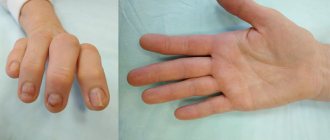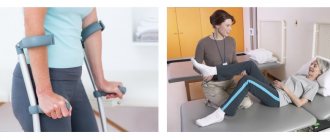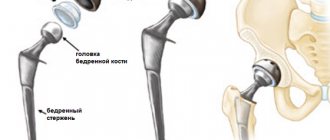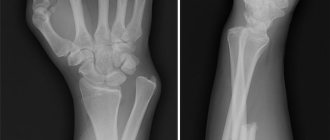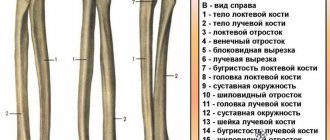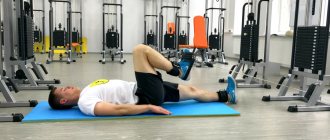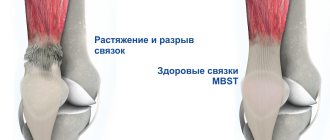Arthrodesis is a surgical operation aimed at restoring the supporting ability of a limb affected by a particular disease or susceptible to injury. Among them it is customary to highlight the following:
- pathological dislocations;
- improperly healed fractures;
- complications of pathologies that lead to dysfunction of the limbs and pronounced pain (arthrosis, arthritis, etc.).
The arthrodesis operation involves complete immobilization of the joint by fusing adjacent bones. In this way, artificial bone ankylosis is created, in which the joint is fixed in the most favorable position.
At CELT you can consult an orthopedic traumatologist.
- Initial consultation – 3,000
- Repeated consultation – 2,000
Make an appointment
Arthrodesis of the joints of the limbs - 150,000 - 200,000 rubles.
Indications
Arthrodesis is performed if the following indications exist:
- Dislocations with displacement.
- Severe stage of arthrosis with decreased joint mobility.
- Incorrect healing of bones after a fracture.
- Deforming arthritis.
- Floppy joint syndrome.
- Inflammatory processes in the joint capsule.
- Clubfoot.
Contraindications
- Chronic diseases of the cardiovascular system.
- Age up to 12 years or over 60 years.
- Allergic reaction to local anesthesia and general anesthesia.
- Phlebeurysm.
- Joint diseases in the acute stage.
- Lesions of the joint capsule with a large accumulation of pus.
- Increased thrombus formation.
Types of arthrodesis
There are 4 types of arthrodesis:
- Extra-articular – performed without damaging the joint in case of tuberculous tissue damage. The joint can be secured through the implantation of a bone graft, which gradually leads to the transformation of cartilage into bone tissue.
- Intra-articular – the joint is opened and the injured cartilage is surgically removed. If indicated, the bone is additionally scraped away from the cartilaginous layer and the synovial membrane is removed. The bones are then secured in the optimal position using pins to allow fusion to occur. Intra-articular surgery is recommended when identifying deforming arthritis and arthrosis.
- Compression - used for intra-articular and extra-articular surgery, but the connection of bones is carried out not by a joint, but by a compression-distraction device (this can significantly speed up healing).
- Displaced - performed with the removal of cartilage tissue and fixation of a bone graft and a metal plate (this allows the joint to be firmly and evenly fixed). Also, for this purpose, specialists can perform tendon-muscle plastic surgery. This type of treatment is recommended for damage to the hip joint and for numerous foot injuries.
The type is determined by the attending physician, taking into account the localization and severity of the inflammatory process.
Arthrodesis of the ankle joint
Arthrodesis of the ankle joint in the vast majority of cases is carried out during the treatment of purulent osteoarthritis. Surgical intervention in this case involves the following:
- removal of the affected part;
- fixation of the talus and tibia together.
The advantage of this method is the elimination of pain, which gradually disappears after surgery. There is, however, a big disadvantage, which is that the area where the operation was performed will remain motionless due to the fixation of the bones. Another disadvantage is the possibility of a purulent process occurring again, this time only without involving the joint. You can exclude the possibility of its occurrence by carefully observing all the rules of asepsis during and after the operation.
Using titanium plate
After surgery
A greater number of fractures in the ankle area occur with displacement of fragments, injury to ligaments and tendons.
The surgeon’s task is to carry out effective surgical treatment, restore the anatomy of the bones and their joints. To do this, the doctor reliably fixes the connected fragments using osteosynthesis, that is, restores the integrity of the bones with the installation of a titanium plate to help them grow together correctly.
Methods of osteosynthesis are:
- closed, extrafocal;
- open.
The closed method involves the use of metal knitting needles. They must be installed without opening the injury site, above and below the injury. Then the needles go to the staples of the Ilizarov apparatus, designed for long-term fixation of bone fragments. The device is adjusted using screws and bolts, after the surgeon displaces the bone fragments under x-rays.
The device must be worn until the bones heal. This is determined by x-rays; a callus should form at the site of injury.
Much more often, open osteosynthesis is performed, when the surgeon compares fragments, removes fragments, and releases pinched soft tissues. Bone fragments must be removed carefully, leaving none behind - this is a prerequisite for performing an operation using any method. The doctor rigidly fixes the combined bones with a plate equipped with several holes and screws. The healing time of the bone depends on how accurately the surgeon aligns the fragments.
The technology for open plate installation is not simple; preliminary modeling of the situation is required - a “drawing” of combining the plate with the bones. In this case, the fixation must be carried out so correctly that the screws do not affect the internal cavity of the articular bones.
The price of the operation depends on the chosen device for fixation: if the Ilizarov apparatus is used repeatedly, only the consumable material – the knitting needles – is changed; then titanium plates are used only once. The cost of the entire operating complex includes the sum of prices only for consumables.
For a double fracture, the intramedullary method is used, when a metal pin is inserted directly into the bone canal. Over time, the latest methods of osteosynthesis operations are being introduced into the practice of traumatology. Intra-articular injuries are combined during surgery using the arthroscopy method. The joints are not opened; small incisions are made to insert a probe with a video camera and special instruments. Small fragments are removed through the incisions, the camera illuminates the areas where soft tissues are pinched to release them, and the fragments are fixed. All the surgeon’s actions are precise, neat, and correct.
Any surgical intervention using the osteosynthesis method requires the application of plaster, which is not removed until a callus forms on the bones - its strength and speed of appearance is determined individually for each person.
Old bone fractures in the ankle area after their improper healing are accompanied by the development of irreversible deformities of the ankle joint. Arthrosis and contracture develop, and complete immobility of the ankle appears. Any changes in the structure of the bone joint of the ankle are accompanied by severe pain.
In this case, patients are offered surgical intervention aimed at restoring mobility and the physiological structure of the ankle. An operation is performed - ankle arthrodesis, where the joint must first be broken and then closed, completely immobilizing it. Recovery should begin immediately after surgery, even when the plate is in place.
Arthrodesis of the subtalar joint
Indications for arthrodesis of the subtalar joint are pathologies and lesions that can ultimately cause disability. These include:
- fractures accompanied by severe pain;
- fracture-dislocations due to a pathology such as arthrosis of the talocalcaneal joint;
- a whole range of orthopedic diseases, from clubfoot to foot deformities.
Surgical intervention in this case is aimed at the following:
- eliminate signs of foot deformity;
- eliminate pain;
- restore the functionality of the foot.
The positive effect of the operation is as follows:
- absence of pain symptoms;
- minimal shortening of the limb, or even its complete absence;
- the ability to wear regular shoes;
- good appearance of the lower leg after surgery.
Arthrodesis of the knee joint
An operation such as arthrodesis of the knee joint is practiced only in extreme situations. Indications:
- severe deforming arthrosis, accompanied by severe pain;
- instability of the knee due to paralysis of the femoral muscles.
The rehabilitation period in this case depends on the individual characteristics of the body and is carried out in a hospital. Contraindications to the procedure include:
- age under 12 and over 60 years;
- the danger of the appearance and development of inflammatory processes in the area of surgical intervention;
- the presence of fistulas of non-tuberculosis nature.
Price
The cost of surgical treatment of an ankle fracture with the installation of a plate depends on the nature of the injury and the degree of joint damage. The price varies in the range of 20-40 thousand rubles. Removing the retainer costs slightly less - 18-20 thousand rubles. The stay at the clinic (service plus rehabilitation) is additionally paid for. The total cost of restoring the functionality of the joint depends on the status of the medical institution and the specifics of the rehabilitation course. Judging by the patient's reviews, at least 60 thousand rubles should be available (including the costs of surgery and the recovery period).
Carrying out the operation
Arthrodesis of the hip joint
- The hip joint is entered through a U-shaped or anterior iliofemoral incision.
- Using clamps, the surgeon spreads and secures the soft tissue so that it does not interfere with the operation.
- The joint is opened and the cartilaginous head of the femur is cut, after which dead tissue is removed and the bone is cleaned.
- Next, a depression is made in the bone tissue to attach the bone graft and a notch is made in the acetabulum.
- The graft is fixed in two zones – the recess and the notch. Pins are used for strong fastening.
- Afterwards, the surgeon applies sutures and a plaster cast from the solar plexus to the knee joint.
- Next, a circular-type plaster cast is attached to the other leg and the connection is made with a spacer to control the position of the hip joint.
Arthrodesis of the elbow joint:
- Penetration into the elbow joint is carried out at the bend using an incision.
- The shavings are removed from the bones of the forearm, after which the bone graft is fixed on the cleaned surface.
- Strong fastening of the graft is achieved through metal plates.
- After this, a plaster cast is applied (recovery takes at least 60 days).
Types of Ankle Fractures
Closed fracture
Fractures are classified according to specific criteria:
- closed, with the skin intact;
- open, with skin damage.
Both types of fractures occur on both the outer and inner ankles, or a bilateral fracture is diagnosed.
Injuries are also classified by type of damage:
- with bone fragmentation;
- in a helical direction;
- with fragments;
- torn;
- fractures combined with dislocation and subluxation of the foot, with damage to the ligaments.
All types of fractures are serious injuries: they are accompanied by visible external changes in the ankle and severe pain. This requires the help of a surgeon who will compare the bone fragments and, if necessary, perform osteosynthesis. Practice shows that closed reposition of bones with the application of plaster is not effective; the patient needs surgery using special equipment - metal knitting needles or a plate.
Postoperative rehabilitation
Recovery can take up to 12 months. The duration of rehabilitation is higher if arthrodesis of the joints of the lower extremities was performed. The patient must use crutches to move around and avoid putting any weight on the operated leg. You can speed up recovery with the help of physiotherapy, exercise therapy, massage and electrophoresis. Physical therapy can only be performed after the cast has been removed and diagnostics have been carried out.
The rehabilitation period reaches 3-4 months if the operation was performed on the metatarsophalangeal, ankle, or knee joint. Recovery can take up to 8-12 months if hip arthrodesis was performed.
Patient reviews
In general, ankle surgery is well tolerated by patients of all age groups. After six months, people forget about the injury. The first two weeks are the hardest to bear, when physical activity is seriously limited. After successful surgery, joint mobility is completely restored. If the doctor has chosen the fixator incorrectly, there may be limitations in the range of motion during rotational movements, turning the foot to the side, up or down. The professional experience and qualifications of the surgeon are the main factors in the success of osteosynthesis, and the speed and quality of recovery depend on the joint efforts of the patient and the doctors of the rehabilitation group.
Possible consequences and complications
Serious complications can only be avoided by choosing an experienced specialist and by 100% following all the doctor’s recommendations after surgery. In rare cases, the following complications are observed:
- Bone graft rejection.
- Anemia due to large blood losses.
- Uneven fusion of joints.
- Injuries to nerve endings during surgery.
- Infection, accumulation of pus and intoxication.
- Thrombosis.
If you experience pain, bleeding, cramps, fever or numbness, immediately contact your doctor for diagnosis and elimination of complications.
Is platinum removal required?
Implant elements used in modern osteosynthesis are made from materials that are highly chemically inert. These include titanium alloys and surgical steels. used for ankle osteosynthesis are highly resistant to corrosion and do not cause a body rejection reaction.
Implants should be removed:
- in case of irritation or mechanical damage to soft tissue implants by plates during a fracture;
- the occurrence of infectious complications;
- clearly expressed wishes of the patient.
Removing ankle anchors before one year after installation is not recommended, but traumatologists advise removing lower limb implants after one year due to the increasing risk of re-injury in the area of ankle osteosynthesis .
Our doctors
Poltavsky Dmitry Ilyich
Traumatologist-orthopedist
Experience 28 years
Make an appointment
Zubikov Vladimir Sergeevich
Traumatologist-orthopedist, Doctor of Medical Sciences, doctor of the highest category, professor
44 years of experience
Make an appointment
Marina Vitaly Semenovich
Traumatologist-orthopedist, head of the minimally invasive traumatology and orthopedics service
Experience 36 years
Make an appointment
Samilenko Igor Grigorievich
Traumatologist - orthopedist, doctor of the highest category
24 years of experience
Make an appointment
